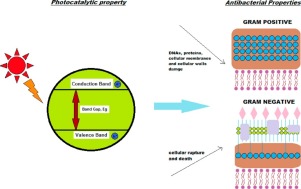当前位置:
X-MOL 学术
›
J. Ind. Eng. Chem.
›
论文详情
Our official English website, www.x-mol.net, welcomes your
feedback! (Note: you will need to create a separate account there.)
Antibacterial activity by ZnO nanorods and ZnO nanodisks: A model used to illustrate “Nanotoxicity Threshold”
Journal of Industrial and Engineering Chemistry ( IF 5.9 ) Pub Date : 2018-06-01 , DOI: 10.1016/j.jiec.2018.01.013 Soh Fanny Chiat Orou , Kee Jeik Hang , Myo Thuya Thien , Yuet Lee Ying , Le Cheng Foh , Nguyen Duong Ngoc Diem , Boon Hee Goh , Swee Yong Pung , Yuh Fen Pung
Journal of Industrial and Engineering Chemistry ( IF 5.9 ) Pub Date : 2018-06-01 , DOI: 10.1016/j.jiec.2018.01.013 Soh Fanny Chiat Orou , Kee Jeik Hang , Myo Thuya Thien , Yuet Lee Ying , Le Cheng Foh , Nguyen Duong Ngoc Diem , Boon Hee Goh , Swee Yong Pung , Yuh Fen Pung

|
Abstract Many studies suggested that waste water treatment using metal oxide nanoparticles, in particular the zinc oxide nanoparticles, appears to be an economical and efficient solution. However, antibacterial activities reported from various research groups were often confusing and contradicting. The present study aimed to evaluate the antibacterial effects and the underlying mechanisms on the custom-engineered Zinc oxice (ZnO) nanorods and ZnO nanodisks. Firstly, antibacterial activities of ZnO nanorods and ZnO nanodisks were studied on both Gram positive and Gram negative bacteria. The antibacterial performance of these ZnO nanoparticles were bench marked with titanium dioxide nanoparticles (TiO2). In antibacterial susceptibility assay, both types of ZnO nanoparticles showed potent inhibition on Bacillus subtilis (B. subtilis) and Staphylococcus aureus (S. aureus) with minimal inhibitory concentration (MIC) at 128 and 256 ug/ml, respectively. Nevertheless, no inhibition was found against Gram negative bacteria. Interestingly, no inhibition was found against both Gram positive and Gram negative bacteria for TiO2 nanoparticles, and thus TiO2 nanoparticles were omitted in the subsequent study. In the time-kill kinetics assay, the inhibitory effect of both types of ZnO nanoparticles on B. subtilis was significant as early as 90 min after treatment at 128 μg/ml. Besides different types of bacteria, generation of reactive oxygen species (ROS), surface area, surface charges, polarity were also examined. Our study suggested that the antibacterial effects of ZnO nanorods and ZnO nanodisks were mediated through not one but multiple chemical and physical properties of nanoparticles. This is the first report introducing a new concept on ‘Nanotoxicity Threshold’, i.e. the maximal tolerance level in bacteria before any damage manifested. Our study warrants that a more holistic view on the mechanistic insights of nanoparticles is required to minimize adverse health effect on human.
中文翻译:

ZnO 纳米棒和 ZnO 纳米盘的抗菌活性:用于说明“纳米毒性阈值”的模型
摘要 许多研究表明,使用金属氧化物纳米颗粒,尤其是氧化锌纳米颗粒处理废水似乎是一种经济有效的解决方案。然而,各个研究小组报告的抗菌活性往往令人困惑和矛盾。本研究旨在评估定制工程氧化锌 (ZnO) 纳米棒和 ZnO 纳米盘的抗菌作用和潜在机制。首先,研究了 ZnO 纳米棒和 ZnO 纳米盘对革兰氏阳性菌和革兰氏阴性菌的抗菌活性。这些 ZnO 纳米颗粒的抗菌性能用二氧化钛纳米颗粒 (TiO2) 进行了基准测试。在抗菌药敏试验中,两种类型的 ZnO 纳米颗粒均显示出对枯草芽孢杆菌 (B. subtilis) 和金黄色葡萄球菌 (S. aureus) 的最小抑菌浓度 (MIC) 分别为 128 和 256 ug/ml。然而,没有发现对革兰氏阴性菌的抑制作用。有趣的是,没有发现 TiO2 纳米颗粒对革兰氏阳性和革兰氏阴性细菌的抑制作用,因此在随后的研究中省略了 TiO2 纳米颗粒。在时间-杀伤动力学测定中,早在以 128 μg/ml 处理后 90 分钟,两种类型的 ZnO 纳米颗粒对枯草芽孢杆菌的抑制作用就很显着。除了不同类型的细菌外,还检查了活性氧 (ROS) 的产生、表面积、表面电荷、极性。我们的研究表明,ZnO 纳米棒和 ZnO 纳米盘的抗菌作用不是通过纳米粒子的一种而是多种化学和物理特性来介导的。这是第一份引入“纳米毒性阈值”新概念的报告,即细菌在出现任何损害之前的最大耐受水平。我们的研究保证,需要对纳米粒子的机理有更全面的认识,以尽量减少对人类健康的不利影响。
更新日期:2018-06-01
中文翻译:

ZnO 纳米棒和 ZnO 纳米盘的抗菌活性:用于说明“纳米毒性阈值”的模型
摘要 许多研究表明,使用金属氧化物纳米颗粒,尤其是氧化锌纳米颗粒处理废水似乎是一种经济有效的解决方案。然而,各个研究小组报告的抗菌活性往往令人困惑和矛盾。本研究旨在评估定制工程氧化锌 (ZnO) 纳米棒和 ZnO 纳米盘的抗菌作用和潜在机制。首先,研究了 ZnO 纳米棒和 ZnO 纳米盘对革兰氏阳性菌和革兰氏阴性菌的抗菌活性。这些 ZnO 纳米颗粒的抗菌性能用二氧化钛纳米颗粒 (TiO2) 进行了基准测试。在抗菌药敏试验中,两种类型的 ZnO 纳米颗粒均显示出对枯草芽孢杆菌 (B. subtilis) 和金黄色葡萄球菌 (S. aureus) 的最小抑菌浓度 (MIC) 分别为 128 和 256 ug/ml。然而,没有发现对革兰氏阴性菌的抑制作用。有趣的是,没有发现 TiO2 纳米颗粒对革兰氏阳性和革兰氏阴性细菌的抑制作用,因此在随后的研究中省略了 TiO2 纳米颗粒。在时间-杀伤动力学测定中,早在以 128 μg/ml 处理后 90 分钟,两种类型的 ZnO 纳米颗粒对枯草芽孢杆菌的抑制作用就很显着。除了不同类型的细菌外,还检查了活性氧 (ROS) 的产生、表面积、表面电荷、极性。我们的研究表明,ZnO 纳米棒和 ZnO 纳米盘的抗菌作用不是通过纳米粒子的一种而是多种化学和物理特性来介导的。这是第一份引入“纳米毒性阈值”新概念的报告,即细菌在出现任何损害之前的最大耐受水平。我们的研究保证,需要对纳米粒子的机理有更全面的认识,以尽量减少对人类健康的不利影响。











































 京公网安备 11010802027423号
京公网安备 11010802027423号